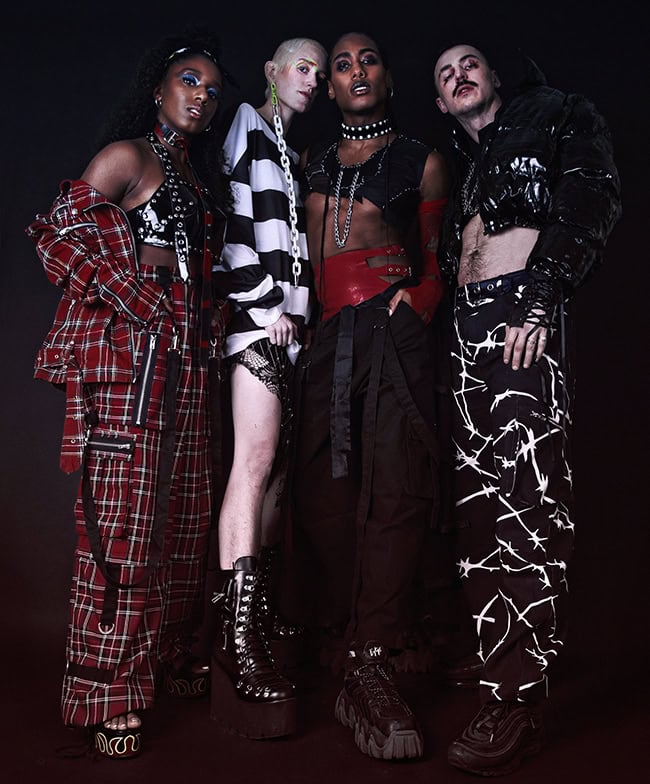Marikiscrycrycry’s He’s Dead as part of Now 20 at The Yard
Posted: February 17th, 2020 | Author: Nicholas Minns & Caterina Albano | Filed under: Performance | Tags: 2Pac, Blue Makwana, Eve Stainton, Gareth Chambers, Jean Genet, Joanna Pope, Jon Cleveland, JONI, Malik Nashad Sharpe, Marikiscrycrycry, Mia Maxwell, Thomas Stichbury, Tupac Shakur, Yukio Mishima, Zeinab Saleh, ¥ummy Online | Comments Off on Marikiscrycrycry’s He’s Dead as part of Now 20 at The YardMarikiscrycrycry, He’s dead, The Yard, February 8

The predominant sensation of Marikiscrycrycry’s He’s Dead, presented as part of Now 20 festival at The Yard, is a density created not only by Jon Cleveland’s thick, blue haze through which we see the choreographed images but by the difficulty in teasing out the motif from its ground. Malik Nashad Sharpe is a cult figure in black/queer theatre where the body signifies both the subject and object of performance; joining them at The Yard in this blend of performance art and dance theatre are Gareth Chambers, Blue Makwana and Eve Stainton, all in Mia Maxwell’s fantastical costumes.
He’s Dead is nominally about the rapper Tupac Shakur, aka 2Pac, widely respected for his stand on fighting inequality and discrimination, who was killed in a drive-by shooting in Los Angeles at the age of 25. Sharpe looks at the narrative of Shakur’s life and asks if he might have been depressed. ‘I think he was, and that isn’t a large part of the narrative behind his aesthetics and his work’, Sharpe explains to Thomas Stichbury in a recent Attitude magazine interview, ‘and I am curious about what that means to someone like me. I want to tease out and materialize a black aesthetics of melancholia and experimentation that allows for the humanity of the things I might feel, and on terms that are not fatal or voyeuristic.’ Sharpe’s form of theatre draws oppression towards them so they can transform it into a complex aesthetic of racial and gender vulnerability that allows them to question their own state of mind as a ‘shy, ambivalent, black femme choreographer’. In one of the more symbolic moments of He’s Dead, a banner with Zeinab Saleh’s portrait of Shakur painted on it is unfurled with Sharpe and Makwana as flag waivers on either side; it is an act of funerary veneration and at the same time one of transference from activist to medium.
Violence is never far from the surface of He’s Dead; its course travels between racial and gender discrimination, united in Sharpe’s body and those of their colleagues. In a scene where Chambers lands several punches on Sharpe’s defenceless body stretched up against the back wall there’s a suggestion of masochistic pleasure, followed by a fight in which a victorious Sharpe deposits Chambers’ body on the front of the stage. At the same time, Sharpe looks beyond violence to its resolution. In one of the most moving scenes, we see them muffled in a cloak with a light inside their cowl searching slowly and silently among bodies on the stage, an illuminated face searching for guidance from the dead. It’s as if somewhere deep in the haunting shadows lurk the figures not only of Tupac but of Yukio Mishima and Jean Genet. Soon after Sharpe shares a ritual cleansing with Makwana that has the sense of religious atonement.
In their desire to confer humanity on their own identity as black and queer, Sharpe creates a rich, almost mystical imagery that corresponds with the sound design of JONI, Joanna Pope, and ¥ummy Online; within this conceptual audio-visual space a dialectic between violence and forbearance is played out in real time. In the initial mix of hard-hitting rap songs, it’s as if we are hearing the music in Sharpe’s head — and perhaps in Shakur’s too; the songs are both the context and the narrative of racial discrimination. But as the work progresses, and the body becomes the context and narrative of gender discrimination, the music subtly changes to give colour and texture to Sharpe’s emotional journey; when they begin to sing before the ritual cleansing, music and the physical body merge. Sharpe comments to Stichbury in the same interview that they use an alter-ego ‘to perfect the practice of crying in front of people, little wails and shouts for one alienated motherfucker — wanting to be seen as human and more and not knowing why.’ Crying is a sign of humanity, of our awareness of beauty and of fragility, but it is too often the abrupt effect of violence, which smothers both. Allowing themself to cry is Sharpe’s defence against the ever-present possibility of violence, but in the creation of He’s Dead they raise the act of crying to a polemical confrontation without its maudlin connotation. As the publicity material states, ‘He’s Dead sheds tears for the things that we cannot unearth.’ The long silence after the performers have left the stage is perhaps an unconscious acknowledgement of what still lies beyond our reach.